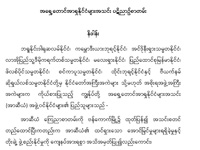The Recent Development on Rakhine State
Press release regarding the attacks on the Border Guard Police posts in Maungdaw Township- 13th October 2016 by the President Office of the Republic of the Union of Myanmar
1. On the morning of 9th October 2016, armed attackers carried out a surprise attack on Kyikanpyin Border Guard Police (Number One) Headquarters, Kotankauk Police Outpost, and Ngakhuya Local Police Office. As a result of this attack, 9 members of the Myanmar Police Force were killed, and 48 weapons of various types and 6624 rounds of assorted ammunition, 47 bayonets, and 164 magazines were lost. Following the defensive actions of the police, the bodies of 8 attackers were found, and 2 attackers were captured alive. From them, 1 homemade pistol, 2 rounds of ammunition, and 1 magazine were recovered.
2. The armed attackers, with the weapons and ammunition they had seized, continued to move around the Maungdaw District and carry out attacks. Tatmadaw infantry units together with members of the Myanmar Police Force have carried out joint combat operations against the attackers. Joint columns of Tatmadaw and police have conducted clearance operations in the areas where the attackers are hiding. During these operations they have had frequently come into armed contact with the attackers. So far, five members of the Tatmadaw have given their lives.
3. According to the initial findings of the interrogations of the two attackers who were captured and two additional attackers whom Bangladesh handed over to Myanmar, the attacks in Maungdaw Township were systematically planned in advance over a long period of time, assisted by foreign funding and the support of members of foreign terrorist organisations.
4. According to the findings of the interrogations, the attacks in Maungdaw were intended to promote extremist violent ideology among the majority Muslim population in the area. Using Maungdaw as a foothold, this was an attempt to take over the areas of Maungdaw and Buthitaung. For this, they received significant financial support from extremist individuals in some Middle Eastern countries. This funding was not provided by particular organisations, but was provided secretly through contacts between individuals.
5. Interrogations have revealed that the attacks in Maungdaw were carried out by the Aqa Mul Mujahidin organisation which is active in Maungdaw, and which is linked to the RSO armed organisation. The leader of this organisation is Havistoohar, a religious and social extremist aged around 45 years old, of Kyaukpyinseik village in Maungdaw Township. He previously attended a six-month Taliban training course in Pakistan, and he has 4 sisters and 1 brother living in Saudi Arabia. Assuming the identity of a refugee, he frequently went to stay in a village near Teknaf in Bangladesh, from where he received funding from organisations based in the Middle East. Among those he worked with were: a Pakistani citizen called Kalis who came to NgaKuRa village after living in Bangladesh; Ibrahim, Aza, and Ayatullah who lived in Kutabaloun refugee camp in Bangladesh; and 12 men living in Nila refugee camp including individuals called Zubaid and Islam. Kalis previously attended a terrorist training camp in Pakistan, and he speaks Myanmar, Bengali, Arakan, Malay and Pakistani languages fluently. Around five months ago, through the arrangement of Havistoohar, Kalis came to Maungdaw and began delivering armed training classes to local extremist youths recruited and mobilised by Havistoohar.
6. The four main instigators in Middle NgaKuRa village, called Abdul Rahman, Munet, Kapiktulah and Akis, had all attended an RSO training course. Havistoohar, Kalis, Mabuya of Maungnama Village (who led the attack on Kyikanpyin), together with 12 attackers who had come from a refugee camp in Bangladesh, had carried out robberies in the villages of Pha Wut Chaung, Ale Than Kyaw and Nga Chaung in Maungdaw Township.
7. According to the findings of the interrogations, Havistoohar and his organisation mobilised extremist youths in the Maungdaw area. They secretly ran weapons training and self-defence training in remote locations in the hills and forests, as well as in the compound of Abdul Rahman in the Middle Nga Ku Ra village, and in the forest near Kyauk Pyin Seik village. Following this, plans were drawn up to carry out violent attacks.
8. Havistoohar had planned for a total of around 400 attackers to simultaneously launch attacks on 6 separate locations: Mabuya would lead around 100 attackers against Kyikanpyin Border Guard Police (Number One) Headquarters; Kalis and Abdul Rahman would lead around 100 attackers against Ngakhuya Police Local Office; Wadif would lead around 50 attackers against Kyain Chaung Local Police Office; Aza would lead around 50 attackers against Kyauk Hlay Kar Local Police Office; Raw Paing would lead around 50 attackers against Ywet Nyo Taung Local Police Office; and Abu Kumar would lead around 12 attackers against Kotankauk Police Outpost. However, on 9th October they were only able to attack three locations: Kyikanpyin, Kotankauk, and Ngakhuya. Havistoohar had instructed that after attacking the bases, the attackers should murder the members of the police, take their weapons and equipment, and use those weapons in further attacks on nearby Tatmadaw and police bases. Before the attacks took place, the organisation leaders systematically explained to the attackers the plan of attack.
9. The Aqa Mul Mujahidin organisation deployed tactics often used in violent armed attacks around the world: receiving foreign funding (from those originally from Maungdaw but now in the Middle East); attending terrorist training courses (delivered by the Taliban in Pakistan, and RSO in Bangladesh); and using religion to mobilise extremist youth in Maungdaw. According to their plan, they intended to take over the majority-Muslim areas of Buthitaung and Maungdaw, and to spread propaganda through disseminating video files on the internet and via social networks, in line with the methods of terrorist organisations such as the Taleban, Al Qaeda and ISIS, in order to attract greater foreign support and funding and encourage the cooperation and participation of domestic and foreign religious extremists.
10. At present, the small armed organisation led by Havistoohar is still attempting to carry out continued attacks in the Maungdaw area with a strength of almost 400 extremist armed attackers. Members of the Myanmar Police Force are taking responsibility for security and rule of law, and Tatmadaw military columns have responsibility for clearance operations. The police and the Tatmadaw are carrying out these responsibilities at full strength. In doing so, they are frequently coming into armed contact with the attackers. At the same time, investigations are continuing into domestic and foreign terrorist links and supporters of terrorism. Further news will continue to be released as it is received, so as to keep the general public informed.
11. The attacks in Maungdaw were systematically planned and prepared over a long period of time with the support and assistance of foreign terrorist organisations and supporters of terrorism. These attacks were an attempt to attack and destroy the security of the nation, and the lives, property and security of the citizens of the country. We will take effective action to defend against, respond to and defeat all armed violent attacks and attempted attacks, in accordance with the Constitution, the anti-terrorism law, and other existing laws relating to security and defence. Not only the attacks in Maungdaw, but all violent attacks or attempted attacks will be responded to effectively, and defeated. We will continue to investigate and identify those controlling and organising the armed attacks from behind the scenes, those who are secretly providing funding, and all organisations and individuals that support armed attacks, and we will take effective action against them. Furthermore, we will take strong action in line with the law against those who try to take advantage of these attacks by instigating or attempting to instigate religious or social conflicts and unrest between communities.
12. We call on our citizens to understand the actions of the government, and to be aware and pay attention to the danger of violent attacks. We call on our citizens to work together with responsible persons to prevent instigation on religious or social grounds within your communities, and to prevent the spread of conflict to other areas. We ask religious and community leaders to make every effort to work together to help to prevent the emergence of conflicts. And we ask our citizens to cooperate with the government for the sake of national security and the defence of the Union.




